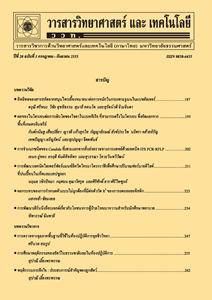Osteoblast Proliferation with Andrographolide and the Development of Debittering Taste of Andrographis Tea Leaf
Main Article Content
Abstract
Isolated andrographolide from the crude acetone extract of Andrographis paniculata leaves promoted osteoblast cell lines proliferation with 152.9±8.6% of cell viability at concentration of 100 µg/mL which was better than that of the control (100±7.1 %). Moreover, at the high concentration of andrographolide (100 µg/mL), it exhibited no cytotoxic against osteoblast cell lines. Therefore, this research aimed to develop a bitter tasted reducing by adding the different types of taste into Andrographis tea to yield 7 tea formulas to improve the taste that was more acceptable from consumers. The tea formula 3 with Tahiti’s juice added, significantly showed the best reduction the bitterness of Andrographis tea at 95 % confidence interval. From the results of this research, it reveals that Tahiti’s juice-added Andrographis tea can be developed to apply for osteoporosis prevention.
Article Details
References
Zhai, Z.J., Li, H.W., Liu, G.W. Qu, X.H., Tian, B., Yan, W., Lin, Z., Tang, T.T., Qin, A. and Dai, K.R., 2014, Andrographolide suppresses RANKL-induced osteoclastogenesis in vitro and prevents inflammatory bone loss in vivo, Br. J. Pharmacol. 171: 663-675.
Weitzmann, M.N. and Pacifici, R., 2006, Estrogen deficiency and bone loss: An inflammatory tale, J. Clin. Invest. 116: 1186-1194.
Khosla, S., Melton, L.J., Atkinson, E.J., O’Fallon, W.M., Klee, G.G. and Riggs, B.L., 1998, Relationship of serum sex steroid levels and bone turnover markers with bone mineral density in men and women: A key role for bioavailable estrogen, J. Clin. Endocrinol. Metab. 83: 2266-2274.
Fink, H.A., Ewing, S.K., Ensrud, K.E., Barrett-Connor, E., Taylor, B.C., Cauley, J.A. and Orwoll, E.S., 2006, Association of testosterone and estradiol deficiency with osteoporosis and rapid bone loss in older men, J. Clin. Endocrinol. Metab. 91: 3908-3915.
Kulyal, P., Tiwari, U.K., Shukla, A. and Gaur, A.K., 2010, Chemical constituents isolated from Andrographis paniculate, Indian J. Chem. 49B: 356-359.
Yongyun, C., Jingwei, Z., Zhiqing, L., Wenxiang, C. and Huiwu, L., 2019, Andrographolide stimulates osteoblasto genesis and bone formation by inhibiting nuclear factor kappa-B signaling both in vivo and in vitro, J. Orthop. Transl. 19: 47-57.
Birhade, S.T., Bankar, V.H., Gaikwad, P.D., and Pawar, S.P., 2010, Preparation and evaluation of cyclodextrin based binary systems for taste masking, Int. J. Pharm. Sci. Drug Res. 2: 199-203.
Pandey, S., Kumar, S., Prajapati, S.K. and Madhav, N.V.S., 2010, An overview on taste physiology and masking of bitter drug, Int. J. Pharm. Bio. Sci. 1: 1-11.
Rashima, R.S., Maizura, M., Kang, W.M., Fazilah, A., and Tan, L.X., 2017, Influence of sodium chloride treatment and poly saccharides as debittering agent on the physicochemical properties, antioxidant capacity and sensory characteristics of bitter gourd (Momordica charantia) juice, J. Food Sci. Technol. 54: 228-235.
Keast, R.S.J. and Breslin, P.A.S., 2002, Modifying the bitterness of selected oral pharmaceuticals with cation and anion series of salts, Pharm. Res. 19: 1019-1026.
Mennella, J.A., Pepino, M.Y. and Beauchamp, G.K., 2003, Modification of bitter taste in children, Dev. Psychobiol. 43: 120-127.
Breksa, A.P., Zukas, A.A. and Manners, G.D., 2005, Determination of limonoate and nomilinoate A-ring lactones in citrus juices by liquid chromatography-electrospray ionization mass spectrometry, J. Chromatogr. A 1064: 187-191.


